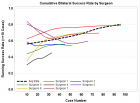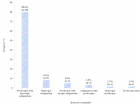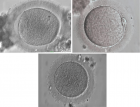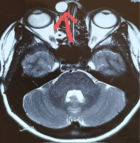Abstract
Research Article
Efficacy of ozonized sunflower oil as treatment of canine generalized demodicosis
Zullyt Zamora Rodriguez*, Marielys Lemus, Eduardo Fleitas González and Oscar Ernesto Ledea Lozano
Published: 18 March, 2021 | Volume 5 - Issue 1 | Pages: 015-021
Background: The acaricidal action of Ozonized sunflower oil (OSO) has demonstrated in different clinical cases of different animal species, such as psoroptic rabbits and pig sarcoptic scabies and recently in demodesic goat.
Objectives: This study evaluated the effectiveness of OSO as treatment for generalized demodicosis mange in dogs.
Animals: Twenty dogs of different breeds, between six months and one year of age with generalized demodicosic mange that attended to Veterinary Clinic “José Luis Callejas” Havana, Cuba, during the year 2015, were included in the study.
Methods: The demodicosis diagnostic was based on its clinical history, the mite’s presence by deep scraping and clinical signs. All cases had a history of receiving before conventional treatments without solution. OSO treatment was topically applied daily, every 12 hours, after shaving all affected areas. Monitoring of clinical signs, mite counting on scaling, pruritus and capillary regrowth (7, 14, 28, 56 and 84 days) were performed.
Results: The results showed a significant reduction of mite counts, clinical signs and pruritus since the 7th day of application. The animals recovered the fur on more than 90% of the body surface. All the animals (100%) recovered from generalized demodesic mange in 84 days of treatment.
Conclusion: The effectiveness and safety of OSO as election treatment of generalized demodicosis mange in dogs was demonstrated.
Read Full Article HTML DOI: 10.29328/journal.ivs.1001030 Cite this Article Read Full Article PDF
Keywords:
Ozonized; Sunflower oil; Demodicosis; Dogs; Demodex canis; Treatment; Mite
References
- Mueller RS, Bensignor E, Ferrer L, Holm B, Lemarie S, et al. Treatment of demodicosis in dogs, 2011 clinical practice guidelines, Vet Dermatol. 2012; 23: 86–e96. PubMed: https://pubmed.ncbi.nlm.nih.gov/22329600/
- Ravera I, Altet L, Francino O, Sánchez A, Roldán W, et al. Small Demodex populations colonize most parts of the skin of healthy dogs. Vet Dermatol. 2013; 24: 168–172. PubMed: https://pubmed.ncbi.nlm.nih.gov/23331694/
- Guaguère E, Beugnet F. Parasitic skin conditions, in A practical Guide to Canine Dermatology, Guaguère E, Prélaud P, Craig M, Eds.Kalianxis: Paris. 2008, 179–226.
- Mueller R. An update on the therapy of canine demodicosis. Compend Contin Educ Vet. 2012; E1–E4. PubMed: https://pubmed.ncbi.nlm.nih.gov/22488596/
- J, Lund, E, Yang, M. A case control study of the risk factors for juvenile-onset generalized demodecosis in the USA. Vet Dermatol. 2011; 22: 95–99. PubMed: https://pubmed.ncbi.nlm.nih.gov/20707860/
- Fourie LJ, Kok DJ, du Plessis A, Rugg D. Efficacy of a novel formulation of metaflumizone plus amitraz for the treatment of demodectic mange in dogs. Vet Parasitol. 2007; 150: 268–274. PubMed: https://pubmed.ncbi.nlm.nih.gov/17923331/
- Paterson T, Halliwell R, Fields P, Louw ML, Louw JP, et al. Treatment of canine-generalized demodecosis: a blind, randomized clinical trial comparing the efficacy of Advocate (Bayer Animal Health) with ivermectin. Vet Dermatol. 2009; 20: 447–455. PubMed: https://pubmed.ncbi.nlm.nih.gov/20178483/
- Hutt JHC, Prior IC, Shipstone MA. Treatment of canine generalized demodicosis using weekly injections of doramectin: 232 cases in the USA (2002–2012). Vet Dermatol. 2015; 26: 345–e373. PubMed: https://pubmed.ncbi.nlm.nih.gov/26190685/
- Mueller R, Meyer D, Bensignor E, Sauter-Louis C. Treatment of canine generalized demodicosis with a “spot-on” formulation containing 10% moxidectine and 2.5% imidacloprid (Advocate, Bayer Healthcare). Vet Dermatol. 2009; 20: 441–446. PubMed: https://pubmed.ncbi.nlm.nih.gov/20178482/
- Pfister K. Fipronil, amitraz and (S)-methoprene – a novel ectoparasiticide combination for dogs. Vet Parasitol. 2011; 179: 293–356. PubMed: https://pubmed.ncbi.nlm.nih.gov/21777729/
- Prullage JB, Cawthorne WG, Le Hir de Fallois LP, et al. Synergy between fipronil and amitraz in a Rhipicephalus sanguineus tick residual contact test. Exp Appl Acarol. 2011; 54: 173–176. PubMed: https://pubmed.ncbi.nlm.nih.gov/21243407/
- Gaxiola S, Gaxiola J, Perez A, et al. Effectiveness of two topical treatments with a combination fipronil/amitraz/(S)-methoprene against natural infestations of mites (Sarcoptes scabiei var. canis) on dogs. Int J Appl Res Vet Med. 2013; 11: 10–15.
- Gassel M, Wolf C, Noack S, Williams H, Ilg T, et al. The novel isoxazoline ectoparasiticide fluralaner: selective inhibition of arthropod gamma-aminobutyric acid and L-glutamate gated chloride channels and insecticide/acaricidal activity. Insect Biochem Mol Biol. 2014; 45: 111-124. PubMed: https://pubmed.ncbi.nlm.nih.gov/24365472/
- Rohdich N, Roepke RK, Zschiesche EA. Randomized, blinded, controlled and multi-centered field study comparing the efficacy and safety of Bravecto™ (fluralaner) against Frontline™ (fipronil) in flea- and tick-infested dogs. Parasit Vectors. 2014; 83: 1-5. PubMed: https://pubmed.ncbi.nlm.nih.gov/24593931/
- Fourie J, Liebenberg J, Horak IG, Taenzler J, Heckeroth AR, et al. Efficacy of oral administration fluralaner (Bravecto®) or topically applied imidacloprid/moxidectin (Advocate ®) against generalized demodicosis in dogs. Parasit Vectors. 2015; 187: 1-7. PubMed: https://pubmed.ncbi.nlm.nih.gov/25881320/
- Karas-tecza J, Dawidowicz J. Efficacy of fluralaner for the treatment of canine demodicosis. Vet Dermatol. 2015; 307: 1-5.
- Duangkaew L, Larsuprom L, Anukkul P, Lekcharoensuk C, Chen C. A field trial in Thailand of the efficacy of oral fluralaner for the treatment of dogs with generalized demodicosis. Vet Dermatol. 2018; 29: 208-e74. PubMed: https://pubmed.ncbi.nlm.nih.gov/29424108/
- Walther F, Paul A, Allan M, Roepke RKA, Nuernberger MC. Safety of fluralaner a novel systemic antiparasitic drug, in MDR (-/-) Collies after oral administration. Parasit Vectors. 2014; 7: 86. PubMed: https://pubmed.ncbi.nlm.nih.gov/24602342/
- Ledea-Lozano O, Martínez E, Garcés R. Aplicación de métodos cromatográficos en la caracterización del aceite de girasol ozonizado, Revista CENIC Ciencias Químicas. 2005; 36.
- Ledea-Lozano O. Estudio de la Composición Química del Aceite de Girasol Ozonizado OLEOZONÒ. Revista CENIC Ciencias Químicas. 2004; 35: 33-34.
- Sánchez Y, Díaz MF, Hernández GD. Antioxidant effects of an ozonized theobroma oil formulation on damaged-inflammatory rat skin. Grasas y Aceites. 2011; 62: 105-110.
- Díaz M, Gavín J, Ledea-Lozano O. Spectroscopic Characterization of Ozonated Sunflower Oil. Ozone Sci Eng. 2005; 27: 247-253.
- Ledea LO, Curtiellas V, Moleiro J. Evidencias del Mecanismo Oxidante en la Actividad Antibacteriana del Aceite de Girasol Ozonizado. Revista CENIC Ciencias Químicas. 2010; 41.
- Curtiellas V, Gómez M, Ledea LO. Actividad Antimicrobiana del OLEOZON® sobre Staphylococcus Aureus y Pseudomonas Aeruginosa. Revista CENIC Ciencias Biológicas. 2005; 36.
- Curtiellas V, Ledea-Lozano O, Rodríguez S. Efectos del OLEOZON sobre la viabilidad, la permeabilidad celular y la ultraestructura de Staphylococcus Aureus. Revista CENIC Ciencias Biológicas. 2008; 39: 128-131.
- Camps RAM, Arias del Toro A. Aplicación tópica del Oleozon como tratamientos alternativos contra la sarna sarcóptica en precebas porcina. Vet Arg. 2013; 308: 1-6
- Camps RAM, Janine PD, Rosales A. Aplicación tópica del Oleozon en la sarna psoróptica del conejo. Vet Arg. 2012; 293: 1-7.
- Camps RAM, Milanes VI, De Lourdes O. Aplicación tópica del Oleozón en caso clínico de lesiones del pabellón de la oreja en un perro. Vet Arg. 2016; 333: 1-8.
- Hernández F, Hernández D, Zamora Z, Díaz M, Ancheta O, et al. Giardia duodenalis: effects of an ozonized sunflower oil product (Oleozon) on in vitro trophozoites. Exp Parasitol. 2009; 121: 208-212. PubMed: https://pubmed.ncbi.nlm.nih.gov/19010325/
- Zamora Z, Torrez D, Bouza M. Oleozon oral, tratamiento efectivo en la giardiasis experimental, Revista CENIC Ciencias Biológicas. 2006; 37: 45-48.
- Zamora Z, Sosa I, Gómez D. Efectividad y eficacia del aceite de girasol ozonizado (AGO) de uso oral como tratamiento de la giardiasis en perros Beagles. REDVET. 2016; 17: 1-13.
- Huang HP, Lien YH. Treatment of canine generalized demodicosis associated with hyperadrenocorticism with spot-on moxidectin and imidacloprid. Acta Vet Scand. 2013; 55: 40. PubMed: https://pubmed.ncbi.nlm.nih.gov/23663380/
- Fourie J, Dumont P, Halos L, Beugnet F, Pollmeier M, et al. Efficacy of a topical application of Certifect_ (fipronil 6.26% w/v, amitraz 7.48% w/v, (S)-methoprene 5.63% w/v) for the treatment of canine generalized demodicosis. Parasite. 2013; 20: 46. PubMed: https://www.ncbi.nlm.nih.gov/pmc/articles/PMC3834659/
- Olivry T, Marsella R, Iwasaki T. Mueller R, International Task Force On Canine Atopic Dermatitis. Validation of CADESI-03, a severity scale for clinical trials enrolling dogs with atopic dermatitis. Vet Dermatol. 2007; 18: 78–86. PubMed: https://pubmed.ncbi.nlm.nih.gov/17355421/
- Hill PB, Lau P, Rybnicek J. Development of an owner-assessed scale to measure the severity of pruritus in dogs. Vet Dermatol. 2007; 18: 301–308. PubMed: https://pubmed.ncbi.nlm.nih.gov/17845617/
- Rybnicek J, Lau-Gillard PJ, Harvey R, Hill PB. Further validation of a pruritus severity scale for use in dogs. Vet Dermatol. 2009; 20: 115–122. PubMed: https://pubmed.ncbi.nlm.nih.gov/19171021/
- Camps RAM, Jiloi A, Milanes VI. Aplicación tópica del Oleozón como alternativa de tratamiento en la sarna localizada en caprinos. Vet Arg. 2016; 344.
- Zamora Z, González Y, Ledón N. Effect of ozonized sunflower oil on Myeloperoxidase activity in the model of ear oedema in mous, REDVET. Revista Electrónica de Veterinaria. 2006; VII.
- Sánchez AA, Díaz PR, Rodríguez GG. et al. Acción del aceite ozonizado sobre la cicatrización de heridas de piel en animales de experimentación, Revista CENIC, Ciencias Biológicas. 1998; 29: 181-183.
- Camps AMR, Claro GNJ, Cuesta GA. Aplicación tópica del Oleozón como alternativa de tratamiento en lesiones causadas por fricción en caballos de tiro, considerando algunos indicadores hematológicos, REDVET, Revista Electrónica de Veterinaria. 2006; 7.
- Camps RAM, Milanes VI, De Lourdes O. et al. Aplicación tópica del Oleozón en caso clínico de lesiones del pabellón de la oreja en un perro. Vet Arg. 2016; 333.
- Singh SK, Dimri U, Sharma MC, Swarup D, Sharma B. Determination of oxidative status and apoptosis in peripheral blood of dogs with sarcoptic mange. Vet Parasitol. 2011b; 178: 330–338. PubMed: https://pubmed.ncbi.nlm.nih.gov/21324594/
- Singh SK, Dimri U, Sharma MC. Swarup D, Sharma B, et al. The role of apoptosis in immunosuppression of dogs with demodicosis. Vet Immunol Immunopathol. 2011a; 144: 487–492. PubMed: https://pubmed.ncbi.nlm.nih.gov/21890219/
- Thannickal VJ, Fanburg BL. Reactive oxygen species in cell signaling. Am J Physiol. Lung Cell Mol Physiol. 2000; 279: L1005–L1028. PubMed: https://pubmed.ncbi.nlm.nih.gov/11076791/
- Shanker K, Singha B, Umesh D. The immuno-pathological conversions of canine demodicosis. Vet Parasitol. 2014; 203: 1–5. PubMed: https://pubmed.ncbi.nlm.nih.gov/24680602/
- Martínez G, Merino N, Sam S. Efecto histológico y bioquímica del OLEOZON® en el modelo de la cola del ratón. Revista CENIC. Ciencias Biológicas. 1997; 28: 31-34.
- Pai SA, Gagangras SA, Kulkarni et al. Potential of Ozonated Sesame Oil to Augment Wound Healing in Rats. Indian J Pharm Sci. 2014; 76: 87–92. PubMed: https://pubmed.ncbi.nlm.nih.gov/24799744/
- Valacchi G, Lim Y, Belmonte G, Miracco C, Zanardi I, et al. Ozonated sesame oil enhances cutaneous wound healing in SKH1 mice. Wound Repair Regen. 2011; 19: 107-115. PubMed: https://pubmed.ncbi.nlm.nih.gov/21134039/
- Kim HS, Noh SU, Han YW, Kim KM, Kang H, et al. Therapeutic effects of topical application of ozone on acute cutaneous wound healing. J Korean Med Sci. 2009; 24: 368-374. PubMed: https://pubmed.ncbi.nlm.nih.gov/19543419/
- Yarim GF, Yagci BB, Ciftci G. Increased circulating concentrations of PDGF-BB and TGF- 1 in canine generalised demodicosis. Revue Med Vet. 2013; 164: 13–17.
- Hiromi K, Masanori S, Humitoshi S. Proinflammatory Event of Ozonized Olive Oil in Mice, Ozone: Science & Engineering. 2009; 31: 238-246.
Figures:
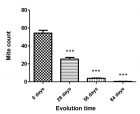
Figure 1
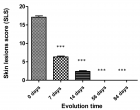
Figure 2
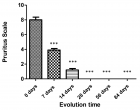
Figure 3
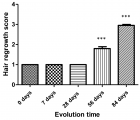
Figure 4
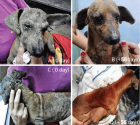
Figure 5
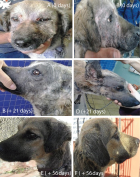
Figure 6
Similar Articles
-
Exploring novel medical applications for commonly used veterinary drug (tilmicosin antibiotic)Fatma I Abo El-Ela*,El-Banna HA. Exploring novel medical applications for commonly used veterinary drug (tilmicosin antibiotic). . 2017 doi: 10.29328/journal.ivs.1001001; 1: 001-016
-
Efficacies of 11% Lactoferricin and 0.05% Chlorhexidine Otological Solution compared, in the treatment of microbial otic overgrowth: A randomized single blinded studyLuisa Cornegliani*,Federico Leone,Francesco Albanese,Mauro Bigliati,Natalia Fanton,Antonella Vercelli. Efficacies of 11% Lactoferricin and 0.05% Chlorhexidine Otological Solution compared, in the treatment of microbial otic overgrowth: A randomized single blinded study. . 2017 doi: 10.29328/journal.ivs.1001004; 1: 032-041
-
Ocular surface Rose Bengal staining in normal dogs and dogs with Keratoconjunctivitis Sicca: Preliminary findingsWilliams DL*,Griffiths A. Ocular surface Rose Bengal staining in normal dogs and dogs with Keratoconjunctivitis Sicca: Preliminary findings. . 2017 doi: 10.29328/journal.ivs.1001005; 1: 042-046
-
Nebulization as complementary therapy for dogs with respiratory tract infectionsStopyra Artur*,Sobiech Przemyslaw,Pomianowski Andrzej,Zarczynska Katarzyna,Edyta Kaczorek. Nebulization as complementary therapy for dogs with respiratory tract infections. . 2019 doi: 10.29328/journal.ivs.1001017; 3: 030-035
-
In vitro antimicrobial activity of a black currant oil based shampoo versus a chlorhexidine 4% shampoo on bacteria strains isolated from canine pyoderma: A comparative studyAntonio Corona*,Paola Persico,Antonella Vercelli,Alessandro Gramenzi,Luisa Cornegliani. In vitro antimicrobial activity of a black currant oil based shampoo versus a chlorhexidine 4% shampoo on bacteria strains isolated from canine pyoderma: A comparative study. . 2020 doi: 10.29328/journal.ivs.1001021; 4: 014-017
-
Efficacy of ozonized sunflower oil as treatment of canine generalized demodicosisZullyt Zamora Rodriguez*,Marielys Lemus,Eduardo Fleitas González,Oscar Ernesto Ledea Lozano. Efficacy of ozonized sunflower oil as treatment of canine generalized demodicosis. . 2021 doi: 10.29328/journal.ivs.1001030; 5: 015-021
-
Corneal stromal abscess and anterior uveitis in a pet goatPanagiotis D Katsoulos*,Konstantinos S Themistokleous. Corneal stromal abscess and anterior uveitis in a pet goat. . 2021 doi: 10.29328/journal.ivs.1001031; 5: 022-023
-
Clinical presentation, diagnosis and therapeutic management of Dipylidium caninum (Cestoda: Dilepididae) infection in a domestic cat (Felis catus): a case reportMd. Shahadat Hossain,Ausraful Islam,Sharmin Shahid Labony,Md. Mokbul Hossain,Md. Abdul Alim,Anisuzzaman*. Clinical presentation, diagnosis and therapeutic management of Dipylidium caninum (Cestoda: Dilepididae) infection in a domestic cat (Felis catus): a case report. . 2021 doi: 10.29328/journal.ivs.1001032; 5: 024-025
-
Comparative characterization between autologous serum and platelet lysate under different temperatures and storage timesCamilo Osorio Florez*, Luis Campos, Jessica Guerra, Henrique Carneiro, Leandro Abreu, Andres Ortega, Fabiola Paes, Priscila Fantini, Renata de Pino Albuquerque Maranhão. Comparative characterization between autologous serum and platelet lysate under different temperatures and storage times. . 2023 doi: 10.29328/journal.ivs.1001038; 7: 001-009
-
Complications of External Otitis in HorsesSchusser GF*, Kuhlmann CHR, Scheidemann W. Complications of External Otitis in Horses. . 2024 doi: 10.29328/journal.ivs.1001041; 8: 012-014
Recently Viewed
-
Relationship between Vitamin D Deficiency and Lipopolysaccharides Porphyromonas gingivalis Bacteria in Stunting ChildrenErwin Gunawan*,Ria Puspitawati. Relationship between Vitamin D Deficiency and Lipopolysaccharides Porphyromonas gingivalis Bacteria in Stunting Children. Ann Biomed Sci Eng. 2024: doi: 10.29328/journal.abse.1001033; 8: 059-065
-
Addiction to self-strangulation: a case-reportAurely Ameller*,Yann Le Strat,Marion Cadranel,Celine Portalier, Caroline Dubertret. Addiction to self-strangulation: a case-report . J Addict Ther Res. 2017: doi: 10.29328/journal.jatr.1001003; 1: 016-021
-
Nanoencapsulated Extracts from Leaves of Bauhinia forficata Link: In vitro Antioxidant, Toxicogenetic, and Hypoglycemic Activity Effects in Streptozotocin-induced Diabetic MiceBárbara Verônica Cardoso de Souza, Alessandra Braga Ribeiro*, Rita de Cássia Meneses Oliveira, Julianne Viana Freire Portela, Ana Amélia de Carvalho Melo Cavalcante, Esmeralda Maria Lustosa Barros, Luís Felipe Lima Matos, Tarsia Giabardo Alves, Maria. Nanoencapsulated Extracts from Leaves of Bauhinia forficata Link: In vitro Antioxidant, Toxicogenetic, and Hypoglycemic Activity Effects in Streptozotocin-induced Diabetic Mice. Arch Pharm Pharma Sci. 2024: doi: 10.29328/journal.apps.1001063; 8: 100-115
-
Oral Suspension as Versatile Galenic Formulation in PediatryMauro Luisetto*, Almukthar N, Edbey K, Mashori GR, Fiazza C, Dona’ l, Cabianca L, Latyshev O. Oral Suspension as Versatile Galenic Formulation in Pediatry. Arch Pharm Pharma Sci. 2024: doi: 10.29328/journal.apps.1001062; 8: 091-099
-
Modulation of Microbiota and its Impact on DepressionKousik Maparu*. Modulation of Microbiota and its Impact on Depression. Arch Pharm Pharma Sci. 2024: doi: 10.29328/journal.apps.1001061; 8: 089-090
Most Viewed
-
Evaluation of Biostimulants Based on Recovered Protein Hydrolysates from Animal By-products as Plant Growth EnhancersH Pérez-Aguilar*, M Lacruz-Asaro, F Arán-Ais. Evaluation of Biostimulants Based on Recovered Protein Hydrolysates from Animal By-products as Plant Growth Enhancers. J Plant Sci Phytopathol. 2023 doi: 10.29328/journal.jpsp.1001104; 7: 042-047
-
Sinonasal Myxoma Extending into the Orbit in a 4-Year Old: A Case PresentationJulian A Purrinos*, Ramzi Younis. Sinonasal Myxoma Extending into the Orbit in a 4-Year Old: A Case Presentation. Arch Case Rep. 2024 doi: 10.29328/journal.acr.1001099; 8: 075-077
-
Feasibility study of magnetic sensing for detecting single-neuron action potentialsDenis Tonini,Kai Wu,Renata Saha,Jian-Ping Wang*. Feasibility study of magnetic sensing for detecting single-neuron action potentials. Ann Biomed Sci Eng. 2022 doi: 10.29328/journal.abse.1001018; 6: 019-029
-
Pediatric Dysgerminoma: Unveiling a Rare Ovarian TumorFaten Limaiem*, Khalil Saffar, Ahmed Halouani. Pediatric Dysgerminoma: Unveiling a Rare Ovarian Tumor. Arch Case Rep. 2024 doi: 10.29328/journal.acr.1001087; 8: 010-013
-
Physical activity can change the physiological and psychological circumstances during COVID-19 pandemic: A narrative reviewKhashayar Maroufi*. Physical activity can change the physiological and psychological circumstances during COVID-19 pandemic: A narrative review. J Sports Med Ther. 2021 doi: 10.29328/journal.jsmt.1001051; 6: 001-007

HSPI: We're glad you're here. Please click "create a new Query" if you are a new visitor to our website and need further information from us.
If you are already a member of our network and need to keep track of any developments regarding a question you have already submitted, click "take me to my Query."






